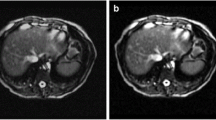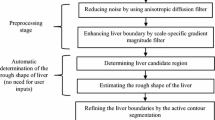Abstract
The accurate liver segmentation for MRI is challenging because of the intensity inhomogeneity. However, most existing intensity inhomogeneity correction sometimes leads to detail smoothing. In this paper, a novel model is proposed for liver segmentation based on the level set method with edge-preserved intensity inhomogeneity correction (EPIICLS). EPIICLS corrects the intensity inhomogeneity with the minimization of the local entropy. And the edge-preserving filter is applied to compensate the detail smoothing by cooperating with the original image. The intensity inhomogeneity correction works on the internal energy of the level set method, which efficiently makes the level set function automatically approximate the signed distance function. And the edge preservation works on the external energy function, which precisely drives the zero-level curve toward the liver boundaries. Experiment results show that the proposed model leads to better segmentation results.




Similar content being viewed by others
References
Shen, J., Baum, T., Cordes, C., Ott, B., Skurk, T., Kooijman, H., Rummeny, E.J., Hauner, H., Menze, B.H., Karampinos, D.C.: Automatic segmentation of abdominal organs and adipose tissue compartments in water-fat MRI: application to weight-loss in obesity. Eur. J. Radiol. 85(9), 1613–1621 (2016)
Bereciartua, A., Picon, A., Galdran, A., Iriondo, P.: 3D active surfaces for liver segmentation in multisequence MRI images. Comput. Meth. Prog. Bio. 132, 149–160 (2016)
Bereciartua, A., Picon, A., Galdran, A., Iriondo, P.: Automatic 3D model-based method for liver segmentation in MRI based on active contours and total variation minimization. Biomed. Signal Proces. 20, 71–77 (2015)
Ahmadvand, A., Kabiri, P.: Multispectral MRI image segmentation using Markov random field model. SIViP 10(2), 251–258 (2016)
Ladgham, A., Hamdaoui, F., Sakly, A., Mtibaa, A.: Fast MR brain image segmentation based on modified Shuffled Frog Leaping Algorithm. SIViP 9(5), 1113–1120 (2015)
Masoumi, H., Behrad, A., Pourmina, M.A., Roosta, A.: Automatic liver segmentation in MRI images using an iterative watershed algorithm and artificial neural network. Biomed. Signal Process. Control 7(5), 429–437 (2012)
Zhang, K., Zhang, L., Lam, K.M., Zhang, D.: A Level Set Approach to Image Segmentation With Intensity Inhomogeneity. IEEE Trans. cybern. 46(2), 546–557 (2016)
Chen, H., Zhen, X., Gu, X., Yan, H., Cervino, L., Xiao, Y., Zhou, L.: SPARSE: seed point auto-generation for random walks segmentation enhancement in medical inhomogeneous targets delineation of morphological MR and CT images. J. Appl. Clin. Med. Phys. 16(2), 387–402 (2015)
Li, C., Huang, R., Ding, Z., Gatenby, J.C., Metaxas, D.N., Gore, J.C.: A level set method for image segmentation in the presence of intensity inhomogeneities with application to MRI. IEEE Trans. Image Process. Publ. IEEE Signal Process. Soc. 20(7), 2007–2016 (2011)
Andersson, T., Romu, T., Karlsson, A., Norn, B., Forsgren, M.F., Smedby, Ö., Kechagias, S., Almer, S., Lundberg, P., Borga, M.: Consistent intensity inhomogeneity correction in water fat MRI. J. Magn. Reson. Imaging 42(2), 468–476 (2015)
Kahali, S., Adhikari, S.K., Sing, J.K.: On estimation of bias field in MRI images: polynomial vs Gaussian surface fitting method. J. Chemometr 30(10), 602–620 (2016)
Ivanovska, T., Wang, L., Laqua, R., Hegenscheid, K.: A fast global variational bias field correction method for MR images. In: International Symposium on Image and Signal Processing and Analysis, pp. 667–671 (2013)
Salvado, O., Hillenbrand, C., Zhang, S., Wilson, D.L.: Method to correct intensity inhomogeneity in MR images for atherosclerosis characterization. IEEE Trans. Med. Imaging 25(5), 539 (2006)
Qiu, T., Wang, A., Yu, N., Song, A.: LLSURE: local linear SURE-based edge-preserving image filtering. IEEE Trans. Image Process. 22(1), 80–90 (2013)
Vovk, U., Pernus, F., Likar, B.: A review of methods for correction of intensity inhomogeneity in MRI. IEEE Trans. Med. Imaging 26(3), 405–421 (2007)
He, K., Sun, J., Tang, X.: Guided image filtering. In: Daniilidis, K., Maragos, P., Paragios, N. (eds.), Computer Vision–ECCV 2010: 11th European Conference on Computer Vision, Heraklion, Crete, Greece, September 5–11, 2010, Proceedings, Part I1-14. Springer, Berlin (2010)
Hussein, A.A., Yang, X.: Colorization using edge-preserving smoothing filter. SIViP 8(8), 1681–1689 (2014)
Suman, S., Kumar, A., Singh, G.K.: A new method for higher-order linear phase FIR digital filter using shifted Chebyshev polynomials. SIViP 10(6), 1041–1048 (2016)
Li, C., Xu, C., Gui, C., Fox, M.D.: Level set evolution without re-initialization: a new variational formulation. In: IEEE Computer Society Conference on Computer Vision and pattern recognition, 2005. CVPR 2005, pp. 430–436 (2005)
Li, C., Xu, C., Anderson, A.W., Gore, J.C.: MRI tissue classification and bias field estimation based on coherent local intensity clustering: a unified energy minimization framework. In: Prince, J.L., Pham, D.L., Myers, K.J. (eds.) Information Processing in Medical Imaging: 21st International Conference, IPMI 2009, Williamsburg, VA, USA, July 5–10, 2009. Proceedings, pp. 288-299. Springer, Berlin (2009)
Acknowledgements
This work was supported by the National Natural Science Foundation of China (Nos.61003175, 81071127 and No81600605),the Fundamental Research Funds for the Central Universities, the Research and Development Funds for Shenzhen Science and Technology (No. JCYJ20160608173106220), the Natural Science Foundation of Liaoning Province of China (No. 20170520153), the natural science fund guidance plan of Liaoning province (No.201602228), General Research Project for Liaoning Provincial Education Department of China (No. L2015146) and Clinical Capability Construction Project for Liaoning Provincial Hospitals, Health and Family Planning Commission, Liaoning Province Government of China (No. LNCCC-D23-2015).
Author information
Authors and Affiliations
Corresponding author
Rights and permissions
About this article
Cite this article
Liu, H., Tang, P., Guo, D. et al. Liver MRI segmentation with edge-preserved intensity inhomogeneity correction. SIViP 12, 791–798 (2018). https://doi.org/10.1007/s11760-017-1221-5
Received:
Revised:
Accepted:
Published:
Issue Date:
DOI: https://doi.org/10.1007/s11760-017-1221-5




